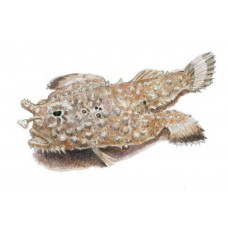Latin name
Ogcocephalus nasutus
Other names
Malthaea notata Valenciennes, Malthaea truncata Valenciennes, Malthe angusta Cuvier, Malthe notata Cuvier, Ogcocephalus nasutus cayennensis Puyo.
Identification
The head and body are wide and flattened, disc-shaped or triangular, and the body is covered with broad spines. Its long pectoral and rod-shaped pelvic fins allow it to move on the seabed. On the front of the head between the eyes is a projection - Rostrum, which can be long or short. Under the rostrum hangs a small tentacle that acts as bait. The mouth is small, but capable of opening wide. The fish is usually heavily armored with bony tubercles and hair-like circles, except for the gill hole on the pectoral fin. Coloration varies in individual species, such as yellowish with a net-like pattern or yellow-white with small black dots. Most are camouflaged by their surroundings. Batfish can be distinguished from goosefish and frogfish by the reduced fins on their heads.
Distribution
Most common in the Gulf of Mexico and southern Florida. Occurs in waters from North Carolina to Brazil. Occurs in Jamaica. In the warm waters of the Atlantic and Caribbean, the long-nosed bat (Ogcocephalus vespertilio) is most often seen, often camouflaged in the sand with its warty, brownish body.
Habitat
Most are found along reefs, dwelling anywhere from the water's edge to 1,500 feet. Some species prefer shallow water. Shallow-water species often inhabit clear water, mostly in rocky areas or at the base of reefs, while deep-water species prefer more open, rocky or clay bottoms.
Size
It can be from 2 to 20 inches long, The average length is 7 inches.
Life history and Behavior
Batfish swim at night, and at other times they partially hide by covering themselves with sand or mud.
Food and feeding habits
They mainly feed on worms and crustaceans, but also eat other fish. They attract their prey by vibration. If a small fish swims close enough, the batfish bursts out of its hiding place and engulfs its prey. Bat fish secrete aromatic secretions that attract prey with their scent. It can swallow fish almost the same size as itself. She suddenly opens her mouth very broadly, creating a suction effect.
Reproduction
No information
| Classification | |
| Phylum | Chordata |
| Class | Actinopterygii |
| Family | Ogcocephalidae |
| Genus | Ogcocephalus |
| Species | O. notatus |
| Features | |
| Conservation status | Least Concern |
| Habitat | bottom |
| Life span, years | no information |
| Maximum body weight, kg | no information |
| Maximum length, cm | 51 |
| Sailing speed, m/s | no information |
| Threat to people | Is not used for food |
| Way of eating | Bentophage |
Batfish
Tags: Batfish



